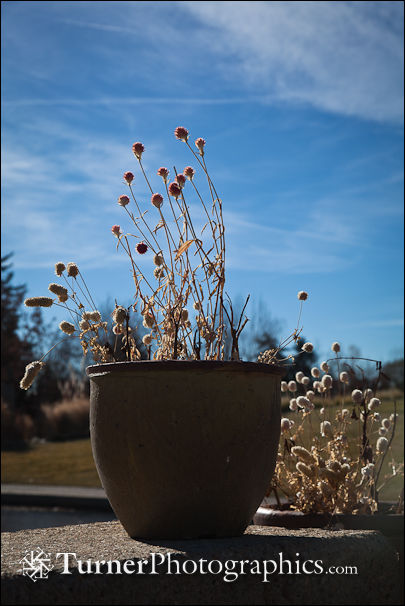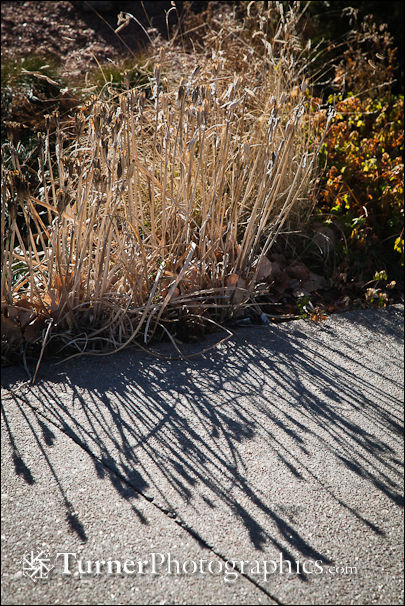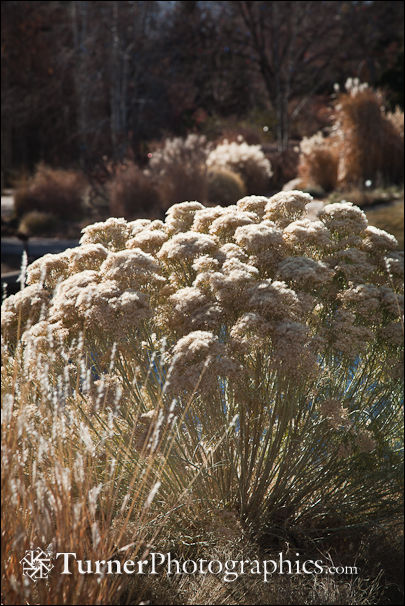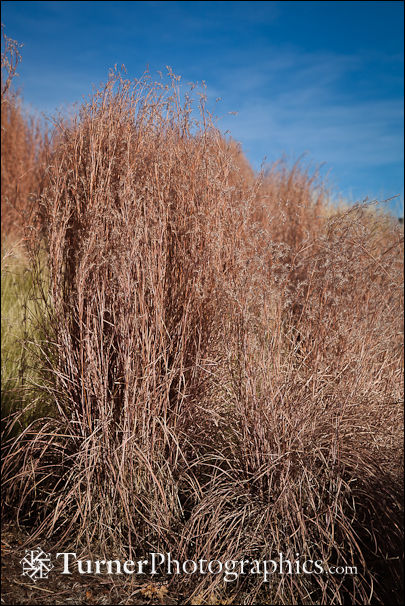A Seedy Affair
 Resist the temptation. Do not get in a hurry to cut down those spent flower stems when the blooms fade.
Resist the temptation. Do not get in a hurry to cut down those spent flower stems when the blooms fade.
Dry flower heads, seedpods really, can be almost as interesting as the flowers were. And many of them are attractive to small birds that come foraging for a mid-day snack.
This container, sitting on a wall in the Denver Botanic Gardens over Thanksgiving weekend, has what I think are Burnet seedheads. At least those elongated pods look a lot like Burnet. But maybe I’m wrong. Doesn’t really matter because they’re interesting sitting there, all dried out, but worshiping rainshadow sunshine.
They’re photographed against the sun and the rich blue sky. The light coming from behind rims each head, turning them into glowing miniature pom-poms. I chose a low camera angle to keep the background uncluttered. In my ideal world the jets would have been grounded. I suppose I could made the contrails disappear with a little retouching.
 Along about May these Rocky Mountain Iris, Iris missouriensis, will be ablaze with rich purple blossoms.
Along about May these Rocky Mountain Iris, Iris missouriensis, will be ablaze with rich purple blossoms.
In November they’re all dried up. The seedpods are full of round, black seeds. Shake them and they’ll rattle. Turn them upside down and the seeds will fill your palm. But this is a public garden so we’d better leave them alone and just imagine the sounds and feeling. Close your eyes and listen for a moment. Think about the hard seeds rolling between your fingers. Imagine them germinating with the warming soil next spring.
I raised my camera up high for this one to capture the long shadows from the low winter sun. The photo is more about the pattern of the shadow than of the iris stems themselves.
Positive – negative, field – ground, which is the subject and which is the background?
That’s your choice.
 I’d never seen much Rubber Rabbitbrush, Ericameria nauseosa, used in a garden until my visit to Denver Botanic. It’s native to dry regions across the entire western half of North America.
I’d never seen much Rubber Rabbitbrush, Ericameria nauseosa, used in a garden until my visit to Denver Botanic. It’s native to dry regions across the entire western half of North America.
Besides the glowing seedpods we have here, Rubber Rabbitbrush brightens the late autumn garden with brilliant yellow blossoms when it blooms in September. The rest of the year the gray-green foliage on this vigorous shrub makes a soft background.
In case you haven’t figured it out yet, I really like photographing dry foliage with the sun streaming through it. It’s hard to go wrong with the technique. This time I’ve included a bit of the grass garden in the background so we get a sense of depth and distance in this two-dimensional representation of a three-dimensional garden.
The dark background also helps the rabbitbrush to stand out. That’s another trick for establishing depth in a photograph.
 About a week ago Panayoti Kelaidis, director of the DBG wrote a blog post in praise of the Bluestem grasses. The garden includes examples of both Little Bluestem, Schizachyrium scoparium, and Big Bluestem, Andropogon gerardii.
About a week ago Panayoti Kelaidis, director of the DBG wrote a blog post in praise of the Bluestem grasses. The garden includes examples of both Little Bluestem, Schizachyrium scoparium, and Big Bluestem, Andropogon gerardii.
I learned these two grasses when I lived in Nebraska in the 1980s and have encountered cultivars of Little Bluestem in a few northwest gardens since then. It’s a beautiful grass, and as Panayoti says it should be cultivated more often.
The grass here is a cultivar of Little Bluestem called ‘The Blues.’ While it has ‘little’ in its name it still grows a bit more than waist high. Contrast that to Big Bluestem which can reach over six feet.
When the pioneers were crossing the eastern great plains on their way to Oregon and wrote about a sea of grass taller than a man it was Big Bluestem they were talking about.
In contrast to the other photos today, this one was shot with front light. Yep, the sun was over my shoulder. Since it was November the light still skimmed in pretty low, and with the low camera angle and blue sky background I think the image works. Remember, rules are made to be broken.

